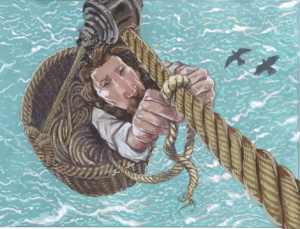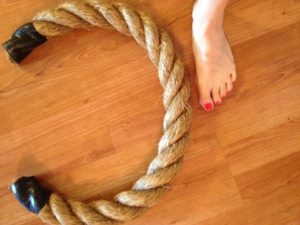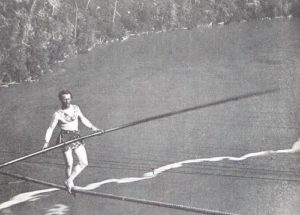They are short and for kids, but nonfiction picture books can require the sleuthing skills of Veronica Mars, the puzzling wizardry of Sherlock Holmes, and the science chops of Bill Nye.
When I set out to write about how The Great Blondin engineered his tightrope across the Niagara Gorge in 1859, I hoped to find the honey pot of details in the countless newspaper articles I uncovered. But instead of a step-by-step reveal, I faced scattered and inconsistent details and humongous gaps in information. Though my picture book narrative couldn’t possibly include every single step, I needed to understand them, to ensure accuracy and a you-are-there sense of tension. Piecing those steps together required that I step out of my comfort zone and into the world of STEMs. Beginning with rope.
The Mysterious STEM of Ropes
You’d think that the simplest detail to nail down would be the rope Blondin performed on, right? Afterall, witnesses could touch the “hawser.” Alas, though most sources correctly estimated the length of the walking rope to be ~1300’ feet long, the rope’s circumference was another matter. Reporters claimed it was 1.5-inches, two, three, 3.25, 3.5, four, six, ten-inches “wide,” “thick,” “diameter,” “around,” “large,” “circumference.” Oy vey! What a snarl to untangle. Was it really that important? Absolutely! There was only one way to solve this hempen-braided mystery, 160-years after the event. I turned to an engineer. Specifically, one with a vested interest in my project—Blondin’s great-great-grandson in France.
The blessed planets aligned for this fortuitous connection. Jean-Louis (thankfully, an English-speaker) and I exchanged clues from historical accounts, then he tapped into his expertise to determine the tension/breaking rate of fiber ropes of different sizes until the mystery was solved. Historical clues + Modern science. Voila! Now I could accurately state that The Great Blondin’s walking rope was 3.25” diameter, or ten+ inches circumference (circumference= diameter X pi [3.1459]). That concrete detail affected every step of Blondin’s process, including the 40,000’ of other ropes. It seems like a lot of effort for something as simple as rope, but accuracy matters. For classrooms, I hope my STEM research mystery inspires a hands-on approach to learning math and engineering concepts.
It’s All About the Questions
Now that the rope mystery was solved, I extracted more research clues to determine necessary questions. How did Blondin and his helpers get the walking rope from the American shore to the Canadian shore in a rowboat? How far upstream did they have to begin to compensate for the wicked current, in those days before human intervention, when 1.5 million gallons of water per second flowed over the Niagara Falls? How did the men transport, attach, lift, transfer, tie, splice, stretch each rope for its intended purpose? Step by step?

Looking back, I see an evolution of my own thought-process in my early diagrams and moodling, often with my engineer-son’s help. The engineering calculations were over my head, to be sure, but my inner Veronica Mars embraced the challenge of connecting the proverbial dots.
Once Blondin’s process was nailed down, I could put Blondin on his rope. Almost.

The Science of Balance
I couldn’t write about a rope-walker without feeling rope beneath my own feet, so I found a four-foot-long, 2 ½”-inch diameter manila rope (the largest available). I walked back and forth on the rope, as it rotated under my feet, and I struggled to keep my balance. More questions emerged: What is balance? How does a balance pole help a tightrope walker? Suddenly, I was a kid again, wobbling on a balance beam, a cavaletti, that crazy swinging playground bridge—oblivious to concepts of gravity, inertia, mass—the secret recipe to keeping me upright. I like to think that, had I read a story like King of the Tightrope: When the Great Blondin Ruled Niagara at that time, I would have been inspired to solve the mystery of my own STEM connection.
I encourage kids to think critically and to embrace historical and STEM topics when I visit schools. To help educators, there’s a curriculum guide, a one-page related STEM glossary, and two experiments to inspire students’ inner Mars/Holmes/Nye.
Find the full curriculum guide and more information at http://www.donnajanellbowman.com/book/king-of-the-tightrope. Follow me at https://www.facebook.com/donnajanellbowmanauthor and on Twitter @donnajbbwrites__________________________________________________________________________
Donna Janell Bowman is the author of award-winning and lauded nonfiction books, including Step Right Up: How Doc and Jim Key Taught the World About Kindness, illustrated by Daniel Minter (Lee and Low, 2016) and Abraham Lincoln’s Dueling Words, illustrated by S.D. Schindler (Peachtree, 2018). STEAM-infused King of the Tightrope: When The Great Blondin Ruled Niagara (Peachtree, 2019) released in October 2019. Donna has an MFA in Writing from Vermont College of Fine Arts. She enjoys mentoring and inspiring writers of all ages, especially during school visits. Donna lives in Central Texas where she does NOT walk on a tightrope.


I just read this book with my son, and we were mesmerized!! What an incredible story–and so well written and researched. I loved all of the little details about how he actually prepped and completed the tighrope walk across Niagra Falls. How cool that you were able to connect with Blondin’s great great grandson in France!! The stars definitely aligned. I also love how you encourage kids to think critically and be problem solvers. You are doing important work!
I’m so delighted that you and your son enjoyed King of the Tightrope. Thanks for your very kind words.